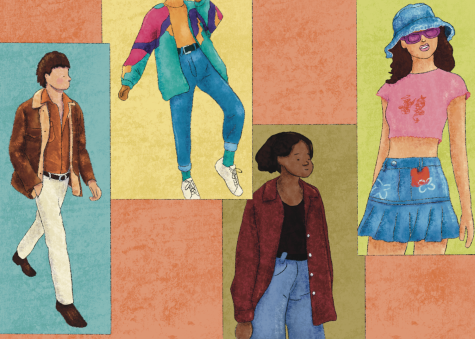Bleached eyebrows and baby tees: Columbia students circle back to fashion trends of the past
December 2, 2022

Whether rocking a flared jean silhouette from the ’70s or flaunting a puffer coat from the early 2000s, Columbia students have taken to a range of styles and trends worn in past eras of fashion.
Lauren Peters, an assistant professor in the Fashion Department, said this phenomenon is due to the “20 year trend cycle,” as trends from the past present themselves as familiar, yet fresh.
“It really is just the nature of trend cycles,” Peters said. “There’s a lot of talk now about micro-trends, especially micro-trends that popped up on social media platforms during the pandemic.”
Within micro-trends, Peters said specifically during the spring and summer on Columbia’s campus she saw students tap into maximalist, avant-basic styles by wearing pastels and electric colors as well as nautical-inspired clothing when tapping into the coastal grandma trend.
Debra Riley Parr, an associate professor in the Art and Art History Department, said during her time at Columbia since 2000, she has seen many ways students express themselves, from post-punk to grunge.
“I think that one thing that I’ve really noticed is how students over the years have really used fashion as a signifier of social and cultural positions, maybe with respect to gender or class,” Parr said. “They’re really attuned to the idea of the visual as a way to signify meaning and belonging, as well as maybe a form of resistance as well.”
With trends such as the return of low rise baggy jeans from Y2K, or the year 2000 — right around the time many current Columbia students were born, first-year fashion studies major Julie Lewis said these trends are not her personal style.
“That’s what I love about fashion is just because I don’t like something doesn’t mean it won’t look great on someone else; there’s something for everyone,” Lewis said.
Looking back further into what trends have spurred from the ’70s, bell bottom jeans and bold patterned florals have made a comeback.
Peters said flared jeans — while known as a trend from the ’70s — were reimagined in the late ’90s and early 2000s.
“If we’re thinking again about the 20 year trend cycle, flares were ubiquitous in the late 1990s and even into the early 2000s. But during that time period, they were referencing the 1970s whenever flares were popular,” Peters said.
From fashion trends that occurred in the ’80s and ’90s, there’s a rising interest on campus of puffer jackets, baby tees and corset tops.
Some Columbia students have taken part in one trend that stretches as far back into the 16th century, which is the bleaching of eyebrows. Peters said as a fashion historian this trend has especially piqued her interest.
“The intensity with which this trend has emerged over the last month just blows me away, because I’ll show up to class to teach and three or four more students will have dyed their eyebrows over the weekend,” Peters said.
The trend, which has inspired influencers like Kim Kardashian, can also be credited to Mona Lisa. Peters said in Europe during the 16th century this trend was meant to give women the appearance of a larger forehead, which was done similarly in Mona Lisa’s famous portrait, as she featured shaved eyebrows to make her forehead appear larger.
Peters said Columbia students are more inspired to express themselves outside of mainstream trends and have taken to reinterpreting them.
“Whenever I talk to especially transfer students who have come to the big state colleges, they say everybody dresses exactly the same,” Peters said. “Whereas at Columbia, it feels like you’re going to a fashion show every day in class.”







